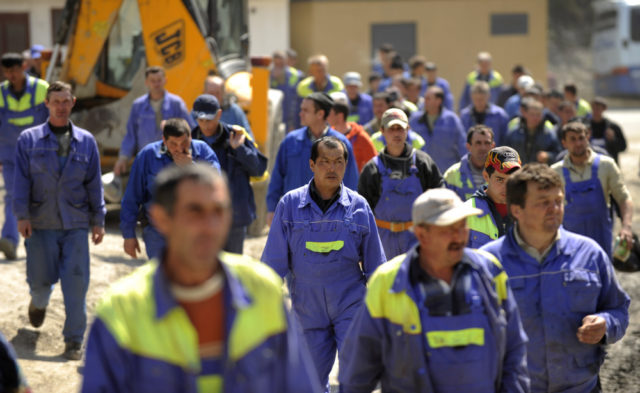
Immigration Collapse Undermines Kremlin Hopes to Recover Russia’s Dominance in Former Soviet Space
Publication: Eurasia Daily Monitor Volume: 16 Issue: 64
By:

The Kremlin is losing the most important “weapon” in its campaign to restore a semblance of Moscow’s former empire in the post-Soviet space. According to Russian commentator Semyon Novoprudky, that weapon is the economic dependence of many post-Soviet countries on the Russian labor market (Spektr.press, April 25). Novoprudsky cites new research by the Moscow-based Gaidar Institute that labor migration from these countries to Russia has declined over the last five years, as other countries, including China, Kazakhstan and the member states of the European Union, increasingly become more important destinations. The report also points out that Russia has little hope of recovering these flows, even if the sanctions regime ends and the Russian economy begins to expand (Ranepa.ru, April 2019). As a result, Russia is becoming less central to the economic existence of its neighbors, less politically influential in them, and less likely to be the center around which they might again coalesce.
As the Gaidar study shows, 2014, the year of Russia’s occupation of Crimea and launch of its war in Donbas, was the decisive turning point. The West’s sanctions regime helped trigger a decline in the Russian economy, resulting in fewer jobs for immigrants, and a decline in the ruble exchange rate. As a result, wages that could be earned in Russia became less valuable to immigrants. Over the last five years, the number of new immigrant workers arriving in the country has remained steady at about 565,000–600,000. But the number departing has increased with every passing year—from 308,000 in 2014 to 441,000 in 2018. As a result, the net increase in the number of immigrant workers last year “turned out to be the lowest since 1991” (Ranepa.ru, April 2019).
Today, as had been the case for most of the last decade, 86 percent of immigrant workers to Russia came from the other former Soviet republics. In the 1990s, many were ethnic Russians or Russian speakers, but those two categories have fallen in size precipitously since then. Those who arrive now are less easily integrated and more likely to spark anti-immigrant feelings among Russians who view them as a threat to their own economic well-being. Most immigrant workers from Commonwealth of Independent States (CIS) countries now originate from Ukraine and Central Asia. However, because of Russian military actions in Ukraine, the number of new Ukrainian immigrant workers has fallen by 30 percent from 2015 to 2018, and the number leaving Russia has grown over these years by 2.6 times. Thus, the Gaidar study concludes, there is no reason to think that these trends will not continue in the future, especially since Ukrainians now have visa-free access to the EU and can acquire higher-paying work in Europe than in Russia.
Net immigration from Central Asia has also fallen, with an increasing number choosing more attractive work opportunities in Kazakhstan and China. Both countries have growing economies and stable currencies, largely because, unlike Russia, they are not locked in a confrontation with the West or suffering from massive sanctions.
These trends all reverse those of the previous two decades, a shift with demographic, economic and ultimately political consequences. Between 1991 and 2014, labor migrants prevented Russia’s demographic collapse. Now, in the last two years, their number has not been enough to cover the decline in the indigenous population of the Russian Federation. Even more importantly, they had prevented an even more radical decline in the Russian working-age population, a group that is declining more rapidly than the population as a whole. As Russia remains committed to an extensive rather than intensive pattern of economic development, the departure of labor migrants is limiting growth, a collateral consequence of Western sanctions on the ruble exchange rate (Ranepa.ru, April 2019).
But it is the political consequences of the immigration decline that the Gaidar study and Novoprudsky emphasize as the most serious. Moscow has long exploited the needs of the former Soviet republics (except Azerbaijan, Kazakhstan, Turkmenistan and Uzbekistan) for higher wages and remittances home from immigrant workers in Russia. (And even in Azerbaijan, Kazakhstan and Uzbekistan, there have, until recently, been enough immigrant workers in Russia to give Moscow leverage.) In Tajikistan, as the Gaidar study points out, roughly half of the country’s Gross Domestic Product (GDP) consisted of such transfer payments as recently as 2015, but that share has since fallen there as well as elsewhere (Spektr.press, April 25; Ranepa.ru, April 2019).
All this points to three main conclusions. First, Russia’s ability to count on immigrants for its own labor needs and to use as leverage against the former Soviet republics has fallen and is unlikely to recover. Most of those who might have come in the past have now refocused on job markets elsewhere, and those now in Russia will leave as a result of local Russians’ hostility and the ruble’s falling exchange rate. Second, Western sanctions have played a key role in this development, not only by limiting Russian economic growth but by driving down the ruble, an impact Moscow feels intensely but that is rarely discussed in the West. And third, with the demise of Russia as a magnet for immigrants, Moscow has lost much of its attraction as a political center, reducing still further any chance of Russian President Vladimir Putin’s dream of imperial restoration.
After all, as Novoprudsky says in his discussion of the Gaidar findings, “One cannot build a new empire on fear alone.” Consequently, he argues, the new wonder-weapons the Kremlin leader likes to talk about (see EDM, February 21, 25, 26) will not compensate for these changes in migration flows, economic ties, and political orientation. Moscow’s own policies, exacerbated by Western sanctions, have ensured that (Spektr.press, April 25).



